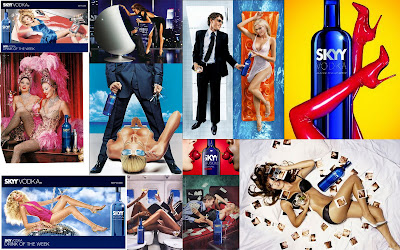Advertising caters to specific genders that fit the consumer market for each specific product. When flipping through a magazine and looking at the ads, it is clear that most of the products are directed towards either males or females. What if the product is gender neutral like vodka? That’s no problem! Just create a gendered consumer market. For example, advertisers for Skyy Vodka chose to specifically target men by using scantily clad women and sexual innuendos to catch attention.
When looking at the Skyy Vodka ads, one may think about why it is being marketed solely to men. Stinem explains, “Traditionally, wines and liquors didn’t advertise to women: men were thought to make the brand decisions, even if women did the buying.” (Stinem, 226) Most ads are directed towards males because subconsciously they still have more power in society. Men are still viewed as the gender in power, regardless of the dichotomy of the home. So if men are in power, they decide what brand of vodka to buy. If the ads were to appeal to both women and men, the company would have to split their marketing styles and work twice as hard. Therefore, by focusing their marketing efforts, Skyy Vodka creates a specific consumer profile that is easy to cater to.
Skyy Vodka rarely pictures men in ads; however, when males are present, they are dressed in suits to look successful and classy and to emulate power. The ads use sex to market to men as well. Jhally claims, “Many commercial messages use images and representations of men and women as central components of their strategy to both get attention and persuade.” (Jhally, 253) Women are eye-catching and desirable for males. Average men view these advertisements and think “ If I drink Skyy Vodka, I can be rich, powerful, and attractive to beautiful women.” Alcohol is usually consumed during social situations; none of the situations pictured in the advertisements are negative or awkward. The advertisements seem to set the scene for possible situations that may occur after consuming Skyy Vodka.
Works Cited
Flying High with Skyy Vodka. Digital image. Web. <http://blogs.longwood.edu/tarastrap/files/2011/06/skyy21-223x300.jpg>.
Horovitz, Bruce. "Skyy Pushes the Envelope with Sexy Ad Campaign - USATODAY.com." News, Travel, Weather, Entertainment, Sports, Technology, U.S. & World - USATODAY.com. Web. 04 Aug. 2011. <http://www.usatoday.com/money/advertising/2010-09-28-vodka28_ST_N.htm>.
Jhally, Sut. "Image-Based Culture: Advertising & Popular Culture." Gender Race and Class in Media. Thousand Oaks: Sage Publications, 2003. 249-57. Print.
Money Women and Vodka. Digital image. Skyy Vodka. Web. <http://ashbug1.files.wordpress.com/2011/01/49skyyvodka_jpg.jpg>.
Showgirls and Vodka. Digital image. Skyy Vodka. Web. <http://130.18.140.19/mmsoc/subliminal/skyy.jpg>.
Sky Vodka sexual campaign. Digital image. Web. <http://patdollard.com/2008/04/skyy%C2%AE-vodka-made-in-the-usa-proudly-supports-treaty-of-guadalupe-hidalgo/>.
Skyy Cherry Flavor. Digital image. Web. <http://i.bnet.com/blogs/skyy-cherry.jpg>.
"SKYY Vodka:: A Double Take | Email Marketing Voodoo." Email Marketing Voodoo | Email Marketing, Email Marketing Agency | MindComet. Web. 04 Aug. 2011. <http://emailmarketingvoodoo.com/blog/post/SKYY-Vodka-A-Double-Take/>.
"Skyy Vodka and Other Premium Vodkas Online at The Champagne Company - PREMIUM SPIRITS - Vodka - Skyy Vodka." The Champagne Company | Champagne Gifts | Fine Wine | Spirits | LSA. Web. 04 Aug. 2011. <http://www.thechampagnecompany.com/premium-spirits/vodka/skyy-vodka/cat_56.html>.
Skyy Vodka by the Pool. Digital image. Web. <http://www.insete.com/weblog/upload/20060708skyy.jpg>.
Steinem, Gloria. "Sex Lies and Advertising." Gender, Race, and Class in Media. Thousand Oaks: Sage Publications, 2003. 223-29. Print.


